Social and Behavioral Science
135 Reconstructing Afromontane Fire Regimes: Exploring the Linkages Between the Aksumite Empire and Deforestation
Corinna A. McMurtrey and Mitchell Power (Geography)
Faculty Mentor: Mitchell Power (Geography, University of Utah)
ABSTRACT
Ethiopian Afromontane forests are biodiverse ecosystems with high rates of endemism and have become increasingly fragmented over the centuries from human-driven deforestation. Consequently, the Ethiopian Highlands have experienced environmental degradation over long time scales from soil erosion, prolonged droughts, and biodiversity loss (Teketay et al., 2010). The Tigray Plateau was once home to the Aksumite Empire, an ancient civilization that rose and fell between c. 50 BCE and 700 CE (Ruiz-Giralt et al., 2021). A favorable climate and advanced agricultural systems allowed for productive yields and substantial food storage to support the Aksumite’s growing population (Connah, 2004). While the Aksum Kingdom experienced several prosperous centuries, the civilization rapidly and mysteriously fell around 700 CE. One of the leading hypotheses suggests that overexploitation of the land led to crop failures and a downfall of agricultural productivity (Connah, 2004).
Aiming to expand on this original hypothesis, this research explores paleoecological evidence of deforestation of Afromontane through reconstructing fire regimes from a time period before the rise of the Aksumites and comparing those data to several centuries of fire history during the rise of the Aksumite Empire. The two comparative time slices offer evidence of potential differences and/or similarities in reconstructed fire history. The method of this research
includes charcoal analysis of a sediment core, KV-II, collected from Adigrat, Ethiopia in 2019. Results suggest fires occurred on average once every ~10 years before the arrival of the Aksumite people and fire tended to be less frequent, occurring once every ~50 years during the peak of the empire. The significant decrease in fire frequency during Aksumite times suggests an overall reduction in available biomass, including increased consumption of wood fuel and expansion of croplands, likely contributing to accelerated deforestation of Afromontane forests.
INTRODUCTION
The Aksumite Empire is an ancient Ethiopian civilization that rose and fell between c. 50 BCE and 700 CE (Ruiz-Giralt et al., 2021). The Aksumites gradually gained wealth and subsequent power through their favorable proximity to major world trade routes running through the Nile River, Red Sea, and Indian Ocean (Connah, 2004). This African civilization was an important player in international politics and one of the first to adopt Christianity. They were the first to mint their own coins, created the Ge’ez written language, hosted several urban centers, and constructed impressive architecture. With an advantageous climate, summer rains brought by the Intertropical Convergence Zone (ITCZ), and advanced agricultural systems (including water- storage dams, ox-drawn ploughs, terracing, and irrigation), the Aksumite Empire enjoyed productive yields allowing for substantial food storage to support their growing population (Connah, 2004).
The Aksumite civilization was situated on the Tigray Plateau of the northern Horn of Africa in modern-day Ethiopia. Extending over ~50,000 kilometers along the Ethiopian Highlands, this plateau is largely formed by the volcanic activity accompanying the East African Rift Zone (Ruiz-Giralt et al., 2021). The resulting irregular landscape ranging from 1,000 to 3,000 meters above sea level makes the area particularly vulnerable to climate and land-use changes (Ruiz-Giralt et al., 2021). Ruiz-Giralt et al. in their 2021 article titled, “Human-
Woodland interactions during the Pre-Aksumite and Aksumite periods in NE Tigray, Ethiopia” notes that these sharp topographical and altitudinal variations greatly impact environmental conditions, producing distinctive microclimates within short distances (Ruiz-Giralt et al., 2021). This vulnerability contextualizes how land-cover changes may have affected the Aksumite Kingdom, as removing vital forests in the region had the capacity to significantly alter the land that the civilization relied on. In fact, geoarchaeological research has shown that intensified land- use and deforestation of the surrounding Afromontane led to soil erosion after 500 CE (Ruiz- Giralt et al., 2021).
With that said, while the Aksum Kingdom experienced several prosperous centuries, the civilization rapidly and mysteriously fell around 700 CE. The leading hypothesis for this collapse suggests that overexploitation of the land led to crop failures and a downfall of agricultural
productivity (Connah, 2004). Karl Butzer, in his 1981 article titled “Rise and Fall of Axum, Ethiopia: A Geo-Archaeological Interpretation,” details the factors that likely contributed to the downfall of the once-prosperous Aksum Kingdom: As the population grew to over ~10,000 people, estimated by Butzer (1981), agricultural demands increased, and the intensified land-use caused significant soil erosion. Combined with seasonal flooding during the rainy months, the land was no longer able to support the Aksumites’ agricultural needs (Butzer, 1981). More specifically, land-use practices like deforestation, over-intensive cultivation, and livestock grazing compounded effects of environmental hazards and accelerated soil degradation (Bard et al., 2000).
As these studies have shown, deforestation, among other land-use practices, likely contributed to the erosion of soil and subsequent crop failures for the Aksum people. Even today, the Ethiopian Highlands suffer from soil erosion, extended droughts, and biodiversity loss due to centuries of deforestation, impacting agriculture and threating the welfare of people, animals,
and other organisms (Teketay et al., 2010). As a result of centuries of vegetation removal, modern analogs of Afromontane ecosystems are rare today on the Tigray Plateau, providing a limited understanding of what these forests looked like before human influence. However, opportunities to understand biodiversity on small-scale modern-day church forests, or sacred forests surrounding churches, monasteries, graveyards, and other sacred sites, provide a window into the species composition of undisturbed Afromontane forests. Church forests in the northern highlands and throughout Ethiopia are protected by the Ethiopian Orthodox Church (Wassie et al., 2010). These biodiverse remnants contribute locally to elevated water tables, reduce surface winds, cooler air temperatures, and support a host of bird species and pollinators that in turn support Ethiopia’s agricultural needs (Eshete et al., 2022). Insights into native and endemic species from these island oases can aid in forest restoration and conservation efforts.
Figure 1: Aerial image of Church Forest, Northern Ethiopia (churchforests.org)
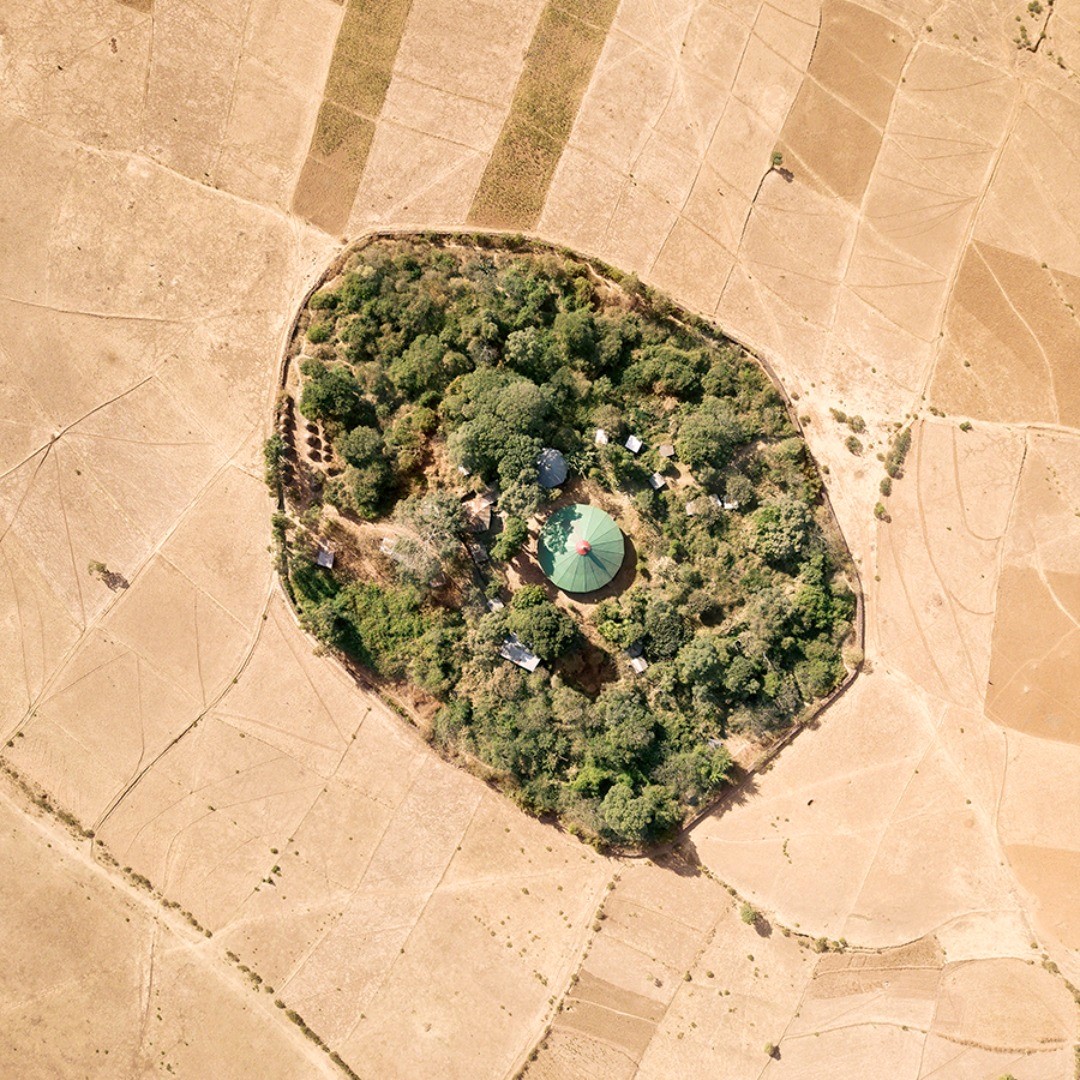
Throughout my research, I was particularly interested in ancient anthropogenic deforestation and to what extent, if any, it may have been a catalyst to crop failures and the eventual collapse of the Aksumite Empire by ~700 CE. Therefore, this research paper aims to explore evidence of deforestation by reconstructing fire regimes from before and after the rise of the Aksumite Empire. This was done through charcoal analysis of sediment cores collected from Adigrat, Ethiopia in 2019. The charcoal analysis explores microscopic (>125µm) charred plant remains as a proxy for reconstructing fire regimes.
Indicators of deforestation in sedimentary analysis can include shifts in charcoal and/or pollen morphologies and abundance. Assuming the Aksumite civilization cleared and burned forest to develop agricultural land, charcoal abundance should increase at that time. In the case of transforming forest to farmland, pollen evidence may shift from Afromontane Forest species to increased abundance of agricultural and grassland taxa. Through reconstructing the Afromontane fire regime of the Ethiopian Highlands, I hypothesize that deforestation initiated by the Aksumite people caused a shift in fire frequency. Conversely, an alternative working hypothesis for a change in fire regime is that natural climate variability caused extreme wet or dry periods which impacted the frequency of fire events. Potentially, both natural and human impacts are linked to past changes in fire regime. One avenue forward in this research is to consider multiple working hypotheses, as T.C. Chamberlain (1965) argues that this method allows a deeper understanding of the various working agencies that may have influenced the results of a scientific study (Hillborn et al., 1997).
Terwilliger et al. (2013) emphasizes the importance of paleoecolocical research by describing how paleoenvironmental records have been a key component in understanding the nature of links between past environments and the rise and fall of ancient civilizations, and how such information can be used to manage consequences of environmental changes today (Terwilliger et al., 2013). By understanding how an environment reacted from specific pressures a past civilization inflicted upon it, we can apply that knowledge to conservation practices today in an effort to prevent historical disasters from repeating.
METHODS
Field
My mentor, Dr. Mitchell Power, completed field work in Adigrat, Tigray, Ethiopia in May 2019 collecting sediment cores from valley floor sediments exposed recently through increased erosion. The site was chosen for its proximity to previously excavated Aksumite archaeological sites, located within ~10-15 km in adjacent valley systems, and previous radiocarbon analysis at the KV-II locality, suggesting the valley floor sediment record spans the past four millennia.
Figure 2: Site Map (green: Afromontane Forest) | Kilat Valley | Core Extraction Site
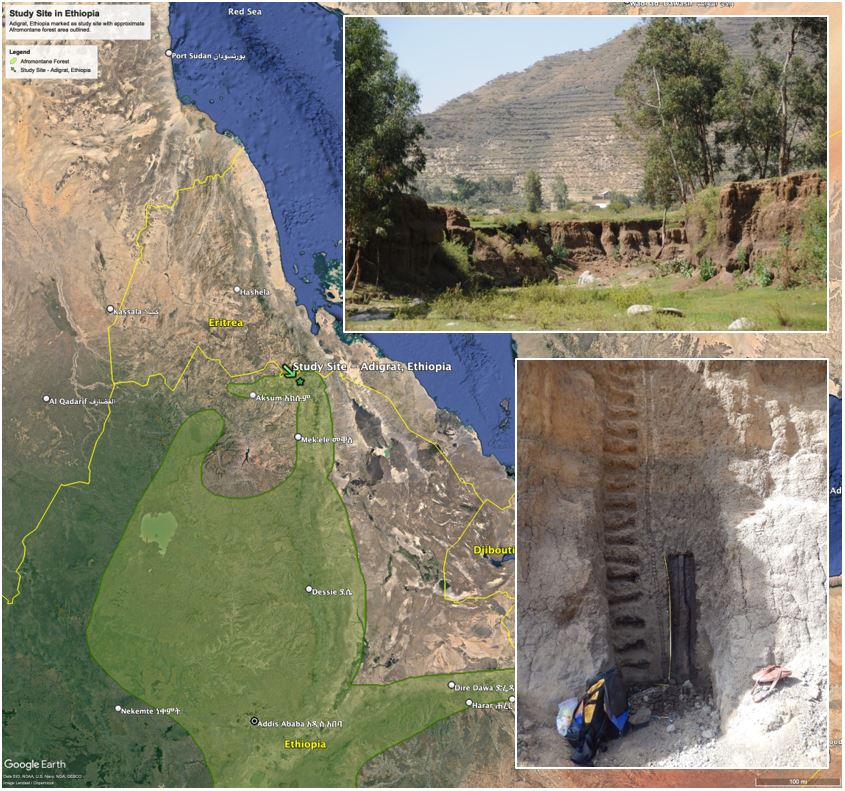
Sediment Core Analysis
To explore evidence of deforestation through charcoal analysis, it was important to examine evidence of fire from before the Aksumite people settled in the region (to use as a control) as well as evidence of fire activity during peak occupation by the Aksumites. Natural disturbance by fire is an essential part of a healthy forest ecosystem, and Afromontane forests likely evolved over thousands of years with lightning-driven wildfires shaping the ecology and natural disturbance regime. The frequency of natural fires is governed by climate, and the climate in Ethiopia is driven by its proximity to the equator, complex topography, and seasonality driven by the ITCZ (Asefa et al., 2020).
Figure 3: Climograph of Adigrat, Ethiopia
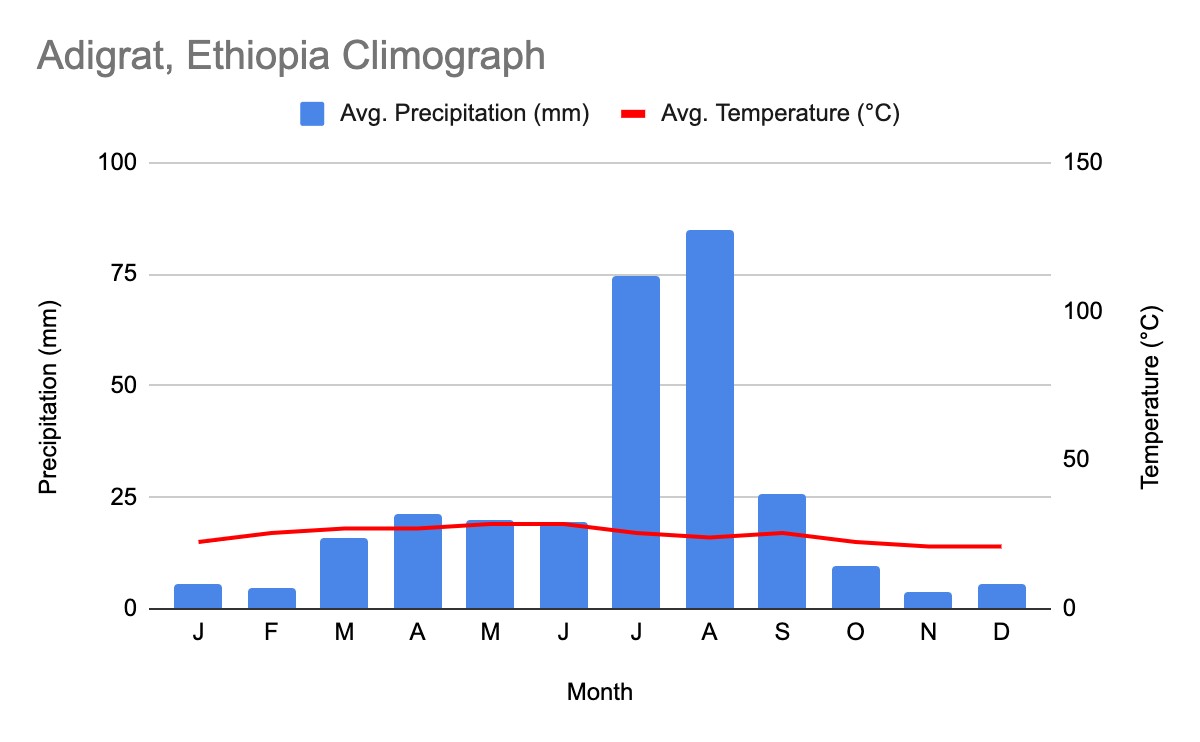
Lab
I began this research journey in the summer of 2022 when we organized the KV-II sediment core segments according to depth and corrected for shrinkage (from water loss while sitting in a fridge for three years) by measuring real vs. original lengths and creating a drawn model of the core. I then created a digital copy of the core using Adobe Illustrator.
Figure 4: Digital and Drawn Stratigraphic Profile of KV-II
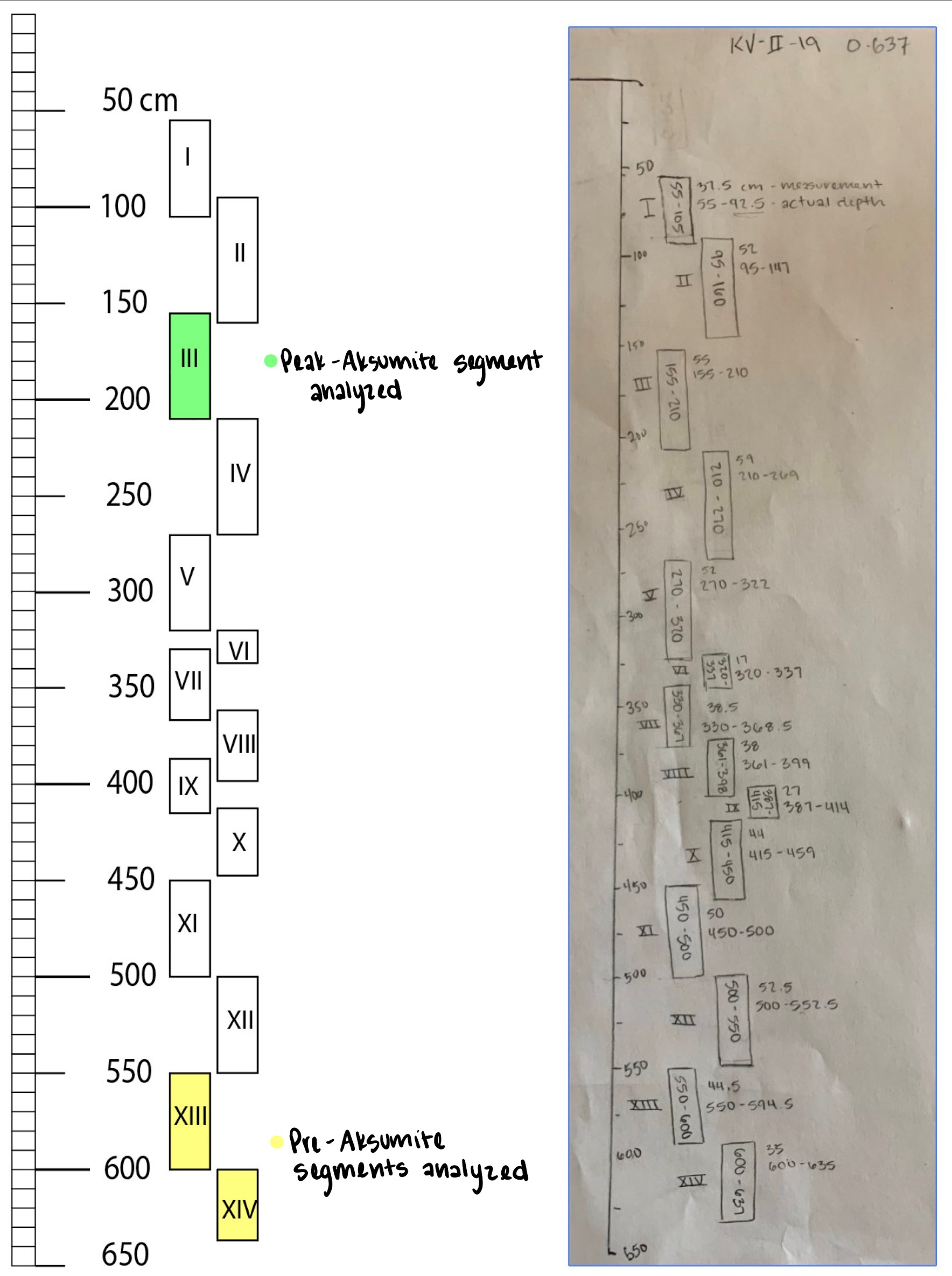
As a chronological control, we selected core segments XIV (depth of 600-637 cm), XIII (550-600 cm), and III (155-210 cm) for sedimentary analysis that would capture pre- and peak- Aksumite occupation. This dating was based on radiocarbon analysis of samples previously submitted by Dr. Power and members of the Ethiopian Tigrai Archaeological Project (ETAP). Analysis of core segments representing pre- and peak-Aksumite Empire were determined by creating an age model (sediment depth versus time) and choosing sediment depths that aligned most strategically with the timing of occupation.
A total of 230 samples were analyzed in the Power Paleoecology Lab of the Natural History Museum of Utah over the course of two semesters. Sediment processing and analysis took place using the following steps:
- Cut 0.5cm of sediment and bagged in sterile Whirl-Pak bags.
- Subsampled 0.5g for analysis and heated in 5ml of 10% KOH (Potassium Hydroxide).
- Sieve through a 125-micron screen
- Placed sediment residue in labeled petri dishes for microscopic analysis.
- Counted charcoal under microscope at 36X magnification.
Figure 5: Core Segment | Sieved Samples | Microscope | Charcoal Particle

RESULTS & DISCUSSION
Figure 6: Pre-Aksumite Fire History of the Kilat Valley – High Resolution
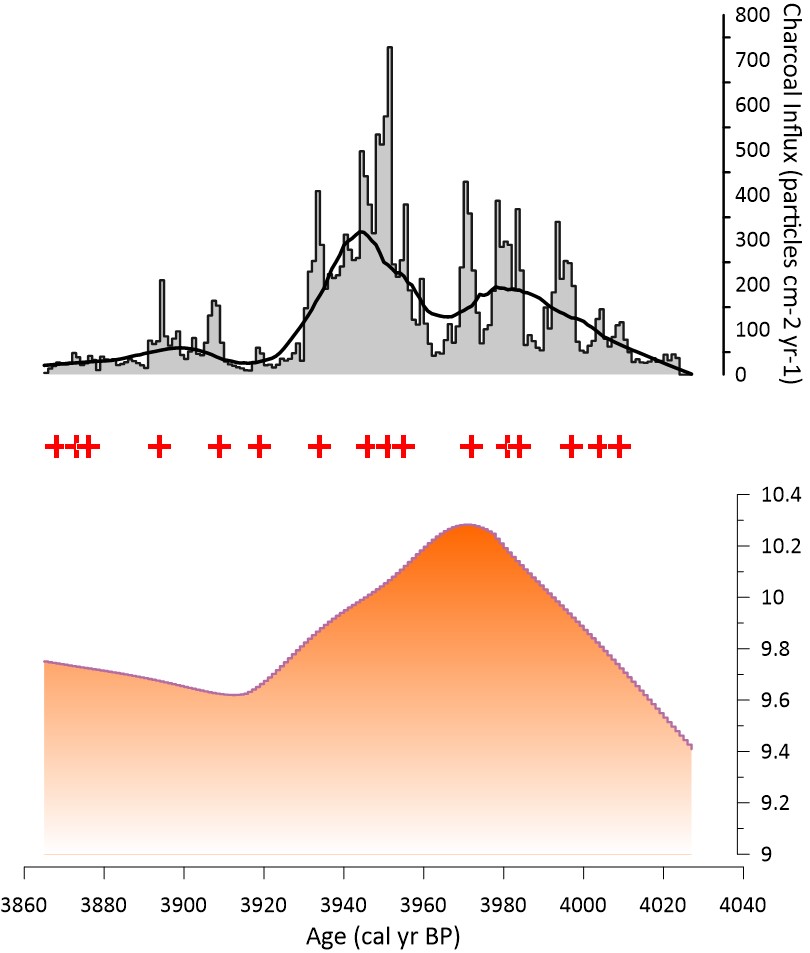
Figure 7: Peak-Aksumite Fire History of the Kilat Valley – High Resolution
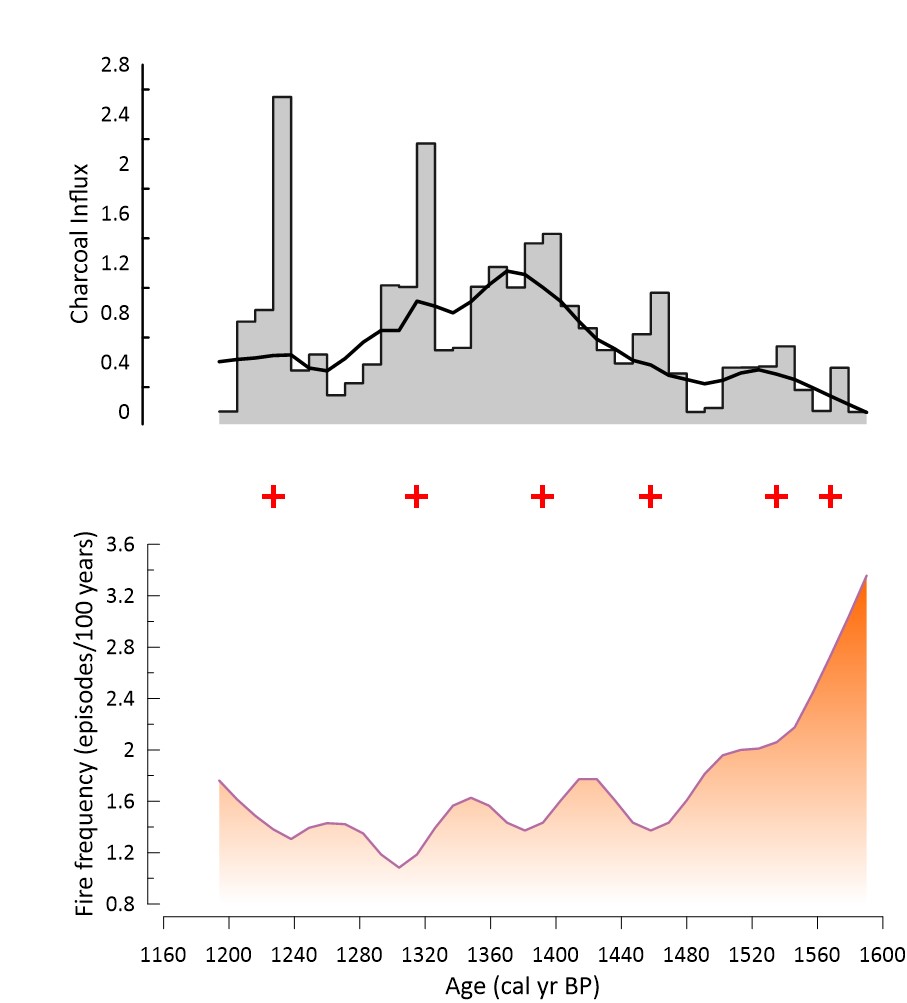
The + symbols in Figures 6 and 7 indicate significant fire events detected with CharAnalysis software (Higuera et al., 2009). In comparing the two time periods of fire history results, the most notable difference is that the average amount of charcoal influx (particles cm-2 yr-1) occur on two different orders of magnitude. For example, the pre-Aksumite fire reconstruction contains influx values exceeding 800 particles cm-2 yr-1, while the peak-Aksumite fire reconstruction includes charcoal influx rarely exceeding 3 particles cm-2 yr-1. Average charcoal influx between these time periods illustrates the vast difference in fire regimes between pre- and peak-Aksumite times.
Pre-Aksumite Afromontane fire regimes suggest decadal-scale fire events with a total of 16 fires during the ~160 years, prior to Aksumite settlement of the area. Fires of this frequency and magnitude would likely require a healthy forest biomass with sufficient fuels and ignition to produce the high charcoal influx values. The largest fire peak occurred approximately ~3950 yr. BP. Following this significant increase in charcoal, a sharp decline occurred around 3970 yr. BP. This apparent decline in charcoal influx may indicate reduced overall vegetation on the landscape driven by either extreme drought and limited fuel to burn, or conversely, extreme wet conditions with a shortened dry season and extended wet season, which may also explain the decline in fire activity.
Reconstructed fire frequency suggests a higher frequency before the Aksumite Empire settled the area (Figure 6), and lower fire frequency during the peak of the empire’s expansion (Figure 7). The Aksumites enjoyed centuries of growth and expansion, with nearly 400 years showing low charcoal influx and only 6 significant fire events, or one occurring every 50 years. The significant decrease in fire frequency points to an overall reduction in fuel availability, potentially aligning with episodes of deforestation, as the Aksumite Empire expanded and citizens consumed wood for fuel, infrastructure, and cooking/heating. The persistent removal of fuel over centuries created a distinct fire regime that suggests humans significantly altered the natural disturbance of Afromontane Forest. Alternatively, the significant decrease in fire frequency during Aksumite times may have been caused by natural climate changes such as a severe dry condition (e.g. limiting vegetation growth/fuel connectivity) or extreme wet climate conditions (reducing the potential for wildfires to occur and spread). A climate-driven shift in fire regime may be unlikely but could be a contributing factor of the initial expansion and ultimate collapse of the Aksumite Kingdom.
Figure 8: KV-II Radiocarbon Age Model
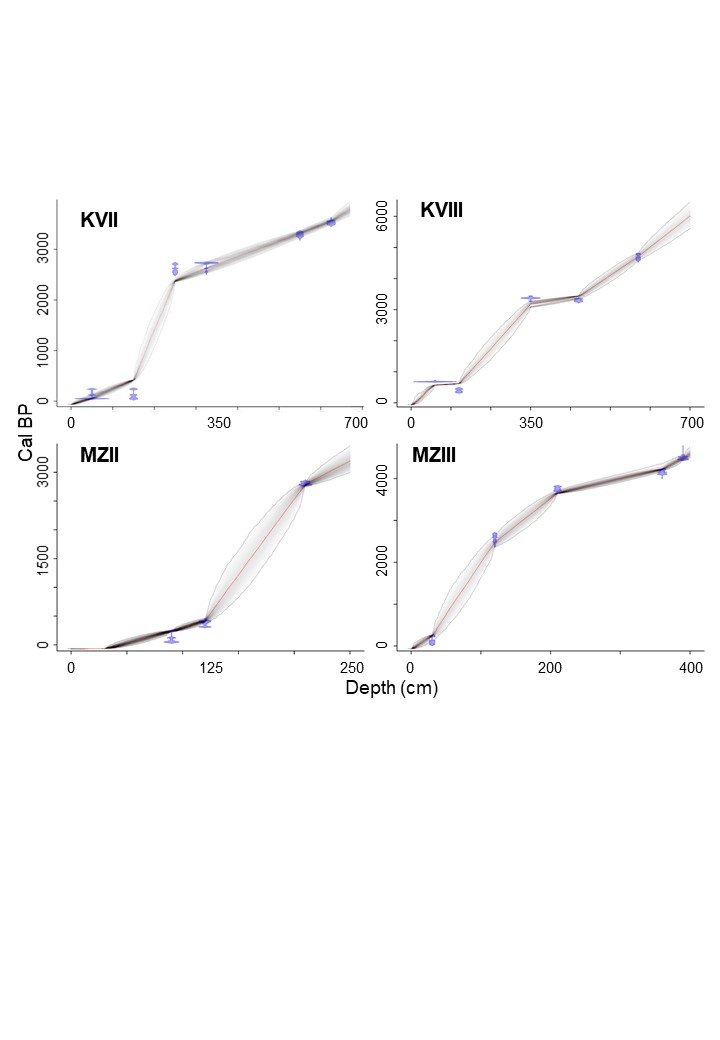
(M. Power, unpublished; Blaauw & Christen, 2011)
A radiocarbon chronology was established through calibrating and modeling the depth:age relationship of six AMS 14C samples (Figure 8). The abrupt change in the age-depth model between 150-250 cm, spans the timeframe of the Aksumite Empire’s peak occupation. The change in sediment deposition rate could be a result of reduced productivity and protracted drought, with a potential link to changes in Afromontane forest abundance.
To understand vegetation changes during the Aksumite Empire, previously published pollen studies offer some insight into vegetation changes. A pollen study conducted on nearby Lake Tana, the largest lake in Ethiopia and the source of the Blue Nile, showed evidence of a severe drought and aridification caused by a southward shift in the ITCZ around 4200 yr. BP. Interestingly, this timeline also coincides with the collapse of Ancient Egypt’s Old Kingdom (Marshall et al., 2011). Although the timeline and location differ from the Aksumite Empire, shifts in the ITCZ may have had a similar effect on the Ethiopian Highlands. A second pollen and charcoal study, conducted on two lakes in the Ethiopian Highlands, discovered evidence of vegetation changes over the last 3000 years from anthropogenic impacts, including forest clearing for agricultural land use. As drought caused human populations to relocate, Afromontane forests were able to regenerate (Darbyshire et al., 2003). Few pollen studies have been published from northern Ethiopia, partly because of the limited pollen preservation in the region, highlighting the need for additional studies to understand how the vegetation may have changed temporally and spatially before and during Aksumite times. More palynological studies are needed to provide additional context into the processes involved as well as the timing of forest loss in the area. Future pollen research should focus on key Afromontane Forest species, including plum pine (Podocarpus), juniper (Cupressaceae), olive (Olea sp.), and hackberries/nettle trees (Celtis sp.).
CONCLUSION
Through this research on changing fire regimes in northern Ethiopia, it is clear that human landcover changes, including the removal of forest for agricultural purposes, began over two millennia ago, and continues today. Afromontane forests of the Ethiopian Highlands, considered one of the world’s biodiversity hotspots and hosts over 7,000 plant species, of which over 30% are endemic (CEPF, 2012), have been contracting over time. Therefore, efforts aimed at conservation and restoration of these vulnerable ecosystems (e.g. Asefa et al. 2020) should include information about the long-term role of fire in shaping these ecosystems.
Recent analysis of Afromontane forests in the Horn of Africa (Figure 9) highlights the rich biodiversity and potential threats facing these systems today (Asefa et al., 2020). Presently, crop and livestock agriculture dominate Ethiopia’s economy, accounting for 53% of their GDP, supporting 80% of their workforce, and 90% of export earnings (Bishaw, 2001). However, recent and ongoing soil erosion, potentially initiated during the Aksumite Empire, has systematically reduced the amount of soil cover, vegetation and soil moisture retention, and significantly altered the natural fire regime. In a recent study by Bishaw (2001), titled “Deforestation and Land Degradation on the Ethiopian Highlands: A Strategy for Physical Recovery,” suggests that modern soil degradation is a direct result of historical and ongoing agricultural practices on the Ethiopian Highlands and is therefore the most immediate environmental issue facing the country. Given this need for soil conservation in Ethiopia, additional knowledge from land-use activities that may have been linked to the Aksumite Empire’s collapse may provide valuable insight for future land management strategies.
Figure 9: Vegetation Schematic (CEPF, 2012; Asefa et al., 2020)
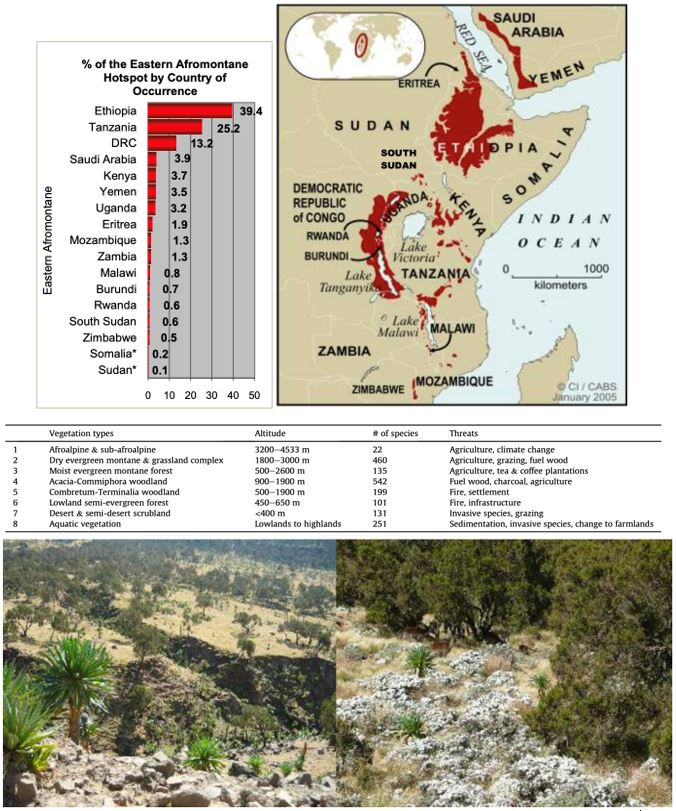
Soil conservation in Ethiopia, including tackling the challenges of increased soil erosion rates, are directly connected to the conversion of woodlands to croplands (Haregeweyn et al., 2015). Millennia of human activities that have changed forest land and vegetation communities include developing agricultural services and harvesting fuelwood (Teketay et al., 2010). It seems likely deforestation and agricultural practices caused destructive soil erosion during the final days of the Aksumite Empire, as overwhelming evidence suggests these practices and consequences are still occurring today. It’s important to note, however, that pollen evidence in sediment core analyses conducted by Darbyshire et al. miraculously signaled that forests in northern Ethiopia could regenerate after as much as 1,800 years of human clearance (Darbyshire et al., 2002). This information is crucial for land conservation in Ethiopia because it indicates that under appropriate land management, with soil and water conservation efforts, forest cover has the capacity to regenerate and mitigate current catastrophes involving soil erosion (Darbyshire et al., 2002).
ACKNOWLEDGEMENTS
First and foremost, I would like to thank Dr. Mitchell Power of the University of Utah’s Geography Department for providing the sediment cores for this research from his field work in Ethiopia in 2019, and for his invaluable mentorship, guidance, and patient encouragement throughout this project. I would also like to share my appreciation for Susana Velasques-Franco, a University of Utah Geography PhD candidate, for training me on various laboratory operating procedures and inspiring me as a fellow woman in STEM. I’m also thankful for my undergraduate research cohort: Talon Roberts and Miranda Clow for shared stories, laughs, and friendship through our combined efforts in paleoecological charcoal analysis in the Power Paleoecology Lab. Thanks to The Natural History Museum of Utah for providing lab space to conduct charcoal analysis; the Office of Undergraduate Research for funding two semesters of my undergraduate research; The Wilkes Center for Climate Science and Policy for funding my graduating semester of research; and the University of Utah Honors College for the opportunity to write this thesis. Finally, I want to extend my deepest gratitude to the Tigrayan people for sharing their land for this research which has truly enriched my personal experience in higher education. Wishing wellbeing, health, and peace to the people of Tigray.
REFERENCES
Asefa, M., Cao, M., He, Y., Mekonnen, E., Song, X., & Yang, J. (2020). Ethiopian vegetation types, climate and topography. Plant Diversity, 42(4), 302–311. https://doi.org/10.1016/j.pld.2020.04.004
Bard, K. A., Coltorti, M., DiBlasi, M. I. C., Dramis, F., & Fattovich, R. (2000). The Environmental History of Tigray (Northern Ethiopia) in the Middle and Late Holocene: A Preliminary Outline. The African Archaeological Review, 17(2), 65–86. https://doi.org/https://www.jstor.org/stable/25130694
Bishaw, B. (2001). Deforestation and Land Degradation in the Ethiopian Highlands: A Strategy for Physical Recovery. Northeast African Studies, 8(1), 7–25. https://doi.org/10.1353/nas.2005.0014
Blaauw, M., & Christen, J. A. (2011). Flexible paleoclimate age-depth models using an autoregressive gamma process. Bayesian Analysis, 6(3), 457–474. https://doi.org/10.1214/ba/1339616472
Butzer, K. W. (1981). Rise and fall of Axum, Ethiopia: A geo-archaeological interpretation.American Antiquity, 46(3), 471–495. https://doi.org/10.2307/280596
CEPF. (2012). Eastern Afromontane. Critical Ecosystem Partnership Fund. Retrieved May 2, 2023, from https://www.cepf.net/our-work/biodiversity-hotspots/eastern-afromontane
Connah, G. (2004). A trading metropolis on the Ethiopian Plateau. In Forgotten africa: An Introduction to Its Archaeology (pp. 69–75). essay, Taylor & Francis Group.
Darbyshire, I., Lamb, H., & Umer, M. (2003). Forest clearance and regrowth in northern Ethiopia during the last 3000 years. The Holocene, 13(4), 537–546. https://doi.org/10.1191/0959683603hl644rp
Eshete, A. W., Dodds, K., & Lowman, M. (2022, December 22). Hierotopia: Spirituality and Ecology of Ethiopian Church Forests. Tree Foundation. Retrieved May 1, 2023, from https://treefoundation.org/2022/12/22/hierotopia-spirituality-and-ecology-of-ethiopian- church-forests/
Haregeweyn, N., Tsunekawa, A., Nyssen, J., Poesen, J., Tsubo, M., Tsegaye Meshesha, D., Schütt, B., Adgo, E., & Tegegne, F. (2015). Soil Erosion and Conservation in Ethiopia. Progress in Physical Geography: Earth and Environment, 39(6), 750–774. https://doi.org/10.1177/0309133315598725
Higuera, P. E., Brubaker, L. B., Anderson, P. M., Hu, F. S., & Brown, T. A. (2009). Vegetation Mediated the Impacts of Postglacial Climate Change on Fire Regimes in the South-Central Brooks Range, Alaska. Ecological Monographs, 79(2), 201–219. https://doi.org/10.1890/07-2019.1
Hilborn, R., Mangel, M., & Chamberlain, T. C. (1997). Appendix: The Method of Multiple Working Hypotheses. In The Ecological Detective: Confronting Models with Data (pp. 281–293). essay, Princeton University Press.
Marshall, M. H., Lamb, H. F., Huws, D., Davies, S. J., Bates, R., Bloemendal, J., Boyle, J., Leng, J., Umer, M., & Bryant, C. (2011). Late pleistocene and holocene drought events at Lake Tana, the source of the Blue Nile. Global and Planetary Change, 78, 147–161. https://doi.org/10.1016/j.gloplacha.2011.06.004
Msaky, E. S., Livingstone, D., & Davis, O. K. (2005). Paleolimnological investigations of anthropogenic environmental change in Lake Tanganyika: V. Palynological evidence for deforestation and increased erosion. Journal of Paleolimnology, 34(1), 73–83. https://doi.org/10.1007/s10933-005-2398-0
Ruiz-Giralt, A., Bouchaud, C., Salavert, A., Lancelotti, C., & D’Andrea, A. C. (2021). Human- woodland interactions during the Pre-Aksumite and Aksumite periods in northeastern Tigray, Ethiopia: Insights from the wood charcoal analyses from Mezber and Ona Adi. Vegetation History and Archaeobotany, 30(6), 713–728. https://doi.org/10.1007/s00334- 021-00825-2
Teketay, D., Lemenih, M., Bekele, T., Yemshaw, Y., Feleke, S., Tadesse, W., Moges, Y., Hunde, T., & Nigussie, D. (2010). Forest Resources and Challenges of Sustainable Forest Management and Conservation in Ethiopia. In T. Tennigkeit & F. Bongers (Eds.), Degraded Forests in Eastern Africa: Management and Restoration (pp. 19–64). essay, Earthscan.
Terwilliger, V. J., Eshetu, Z., Disnar, J.-R., Jacob, J., Paul Adderley, W., Huang, Y., Alexandre, M., & Fogel, M. L. (2013). Environmental changes and the rise and fall of civilizations in the northern Horn of Africa: An approach combining δd analyses of land-plant derived fatty acids with multiple proxies in soil. Geochimica Et Cosmochimica Acta, 111, 140–
- https://doi.org/10.1016/j.gca.2012.10.040
Wassie, A., Sterk, F. J., Teketay, D., & Bongers, F. (2010). Church Forests – Relics of Dry Afromontane Forests of Northern Ethiopia: Opportunities and Challenges for Conservation and Restoration. In F. Bongers & T. Tennigkeit (Eds.), Degraded forests in Eastern Africa: Management and Restoration (pp. 123–132). essay, Earthscan.

